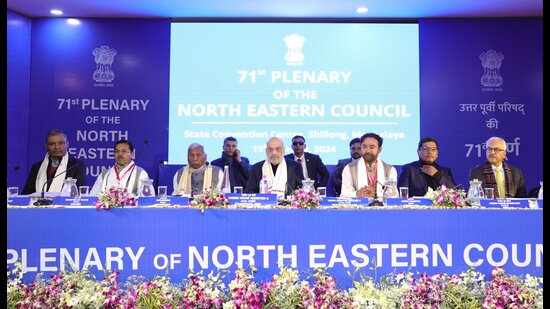The case for including North Bengal in NEC
The integration of North Bengal into the North Eastern Council (NEC), which has gained attention recently, is not a novel concept. It is actually a viable solution that addresses various challenges the people of North Bengal face. The region has long been neglected, with the meagre development in West Bengal so far being Kolkata-centric, and only South Bengal reaping its benefits.
Union home minister Amit Shah at the 71st Plenary Session of the Northeast Council in Shillong (Twitter/@AmitShah) (Twitter/@AmitShah)
Given the continued inattention to North Bengal, the people of the area have often demanded its separation from the rest of the state. Thus, North Bengal has seen a number of political movements centred on separation — statehood calls raised by the Gorkhas, Rajbanshis, and Kamtapuris reflect the frustration of some of the neglected communities.
The eight districts located north of the Ganga in the state — Darjeeling, Kalimpong, Jalpaiguri, Cooch Behar, Malda, Uttar Dinajpur, Dakshin Dinajpur and Alipurduar — are collectively called North Bengal. Historically, this area was a transitional zone between Eastern India and the great Gangetic plain. Today, these districts are among the most neglected parts of West Bengal, despite being vital both strategically and from the security perspective.
A major part of North Bengal is defined by the Siliguri Corridor, which is significant due to its location near the so-called Chicken’s Neck that links the northeastern states to the rest of India. The Siliguri Corridor also neighbours Nepal, Bhutan, Bangladesh, and China, and connects India to South East Asia and East Asia through Myanmar. This makes it strategically important to India. The massive improvements in infrastructure in the Northeast are there for all to see. The need of the hour is to develop the Siliguri Corridor as a bridge to South East Asia by augmenting its infrastructure and plugging it into emerging trans-Asian connectivity networks. This might be possible only if North Bengal is independently resourced.
Across the world, economic synergies within sub-regions divided by political boundaries are being regenerated. Common infrastructure and economic spaces that acknowledge this contiguity are the foundation of such arrangements. The concept of a composite Northeast is an acknowledgement of this rationale. Viewed from this perspective, the synergies that can be exploited by — and the logic of — linking North Bengal to the Northeast are evident. Moreover, by including the Siliguri Corridor, the Northeast will assume a contiguity with Sikkim that it is currently lacking.
The benefits of such arrangements spread beyond their epicentres. Bengal has always been a maritime state. Strengthening land linkages with the Northeast via North Bengal would create an opportunity for the whole of the state to expand its historical role as the gateway to the Bay of Bengal. The economic weight of the hinterland, which made Kolkata (Calcutta) port one of the great economic hubs of its time, would be rekindled by reviving this organic connection to the Northeast.
Prime Minister Narendra Modi’s focus on developing infrastructure in the Northeast, Neighbourhood First and Act East foreign-policy pillar gives North Bengal a historic opportunity. The NEC, as the nodal agency for the economic and social development of India’s Northeast, gets ~10% of annual budgets of all central ministries. The common roadblocks to development that the northeastern states share are applicable to North Bengal as well but the benefits of the NEC do not extend to the region and its people.
The Northeast, from Sikkim in the west to Arunachal Pradesh in the east, is in the eastern Himalayan range and, as such, the ethnic groups in these areas share significant cultural and ethnic similarities. The populations of Darjeeling and Sikkim predominantly comprise groups such as the Lepchas, Bhutias, and Nepalis. Their shared physical characteristics are a testament to their common ancestry. The lifestyles of the people in Darjeeling, Kalimpong, Sikkim and Arunachal Pradesh are closely linked to their mountainous environment. Darjeeling and Kalimpong are the only hilly districts of West Bengal, and owing to the terrain, residents face distinct challenges that can’t be addressed by the ‘one size fits all’ policies of the West Bengal government. Additionally, areas of North Bengal, including Jalpaiguri, Cooch Behar, Uttar Dinajpur, and Alipurduar, exhibit cultural affinities with Assam. The Rajbanshi, Adivasi, and various tribal communities, such as the Bodos and Rabhas, inhabit both regions. These groups have intermingled over centuries, resulting in shared cultural traits and practices. Assamese is widely understood and spoken in parts of North Bengal, alongside Bengali.
Despite the immense potential, North Bengal faces myriad issues that hinder its progress, from infrastructural deficiencies to socioeconomic disparities. Its road and rail networks are insufficient to support its growing population and economic activities. Frequent landslides and flooding, exacerbated by poor drainage systems, further disrupt connectivity. Health care and education services in North Bengal are also lagging. Economic development is another area of concern. While agriculture remains the backbone of its economy, it is marred by low productivity, and inadequate access to modern agricultural techniques and markets. The tea industry, a significant economic driver, faces challenges such as fluctuating global prices, labour disputes, and environmental degradation. The region grapples with socio-political issues, including ethnic tensions and demands for greater autonomy.
These challenges underscore the current lack of resources to leverage the region’s strengths. Consequently, making North Bengal a part of the NEC is a potential solution. A well-administered, well-resourced, and secure North Bengal region holds immense significance for the country, both strategically and economically.
Harsh Vardhan Shringla is former foreign secretary, and former ambassador to the US, Bangladesh and Thailand.The views expressed are personal
Images are for reference only.Images and contents gathered automatic from google or 3rd party sources.All rights on the images and contents are with their legal original owners.


Comments are closed, but trackbacks and pingbacks are open.